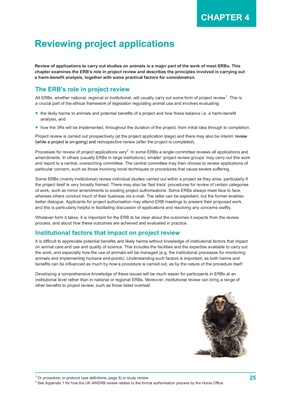
25
The ERB's role in project review
All ERBs, whether national, regional or institutional, will usually carry out some form of project review1
. This is
a crucial part of the ethical framework of legislation regulating animal use and involves evaluating:
the likely harms to animals and potential benefits of a project and how these balance i.e. a harm-benefit
analysis, and
how the 3Rs will be implemented, throughout the duration of the project, from initial idea through to completion.
Project review is carried out prospectively (at the project application stage) and there may also be interim review
(while a project is on-going) and retrospective review (after the project is completed).
Processes for review of project applications vary2
. In some ERBs a single committee reviews all applications and
amendments. In others (usually ERBs in large institutions), smaller "project review groups" may carry out this work
and report to a central, overarching committee. The central committee may then choose to review applications of
particular concern, such as those involving novel techniques or procedures that cause severe suffering.
Some ERBs (mainly institutional) review individual studies carried out within a project as they arise, particularly if
the project itself is very broadly framed. There may also be "fast track" procedures for review of certain categories
of work, such as minor amendments to existing project authorisations. Some ERBs always meet face to face,
whereas others conduct much of their business via e-mail. The latter can be expedient, but the former enables
better dialogue. Applicants for project authorisation may attend ERB meetings to present their proposed work,
and this is particularly helpful in facilitating discussion of applications and resolving any concerns swiftly.
Whatever form it takes, it is important for the ERB to be clear about the outcomes it expects from the review
process, and about how these outcomes are achieved and evaluated in practice.
Institutional factors that impact on project review
It is difficult to appreciate potential benefits and likely harms without knowledge of institutional factors that impact
on animal care and use and quality of science. This includes the facilities and the expertise available to carry out
the work, and especially how the use of animals will be managed (e.g. the institutional processes for monitoring
animals and implementing humane end-points). Understanding such factors is important, as both harms and
benefits can be influenced as much by how a procedure is carried out, as by the nature of the procedure itself.
Developing a comprehensive knowledge of these issues will be much easier for participants in ERBs at an
institutional level rather than in national or regional ERBs. Moreover, institutional review can bring a range of
other benefits to project review, such as those listed overleaf.
CHAPTER 4
Reviewing project applications
Review of applications to carry out studies on animals is a major part of the work of most ERBs. This
chapter examines the ERB's role in project review and describes the principles involved in carrying out
a harm-benefit analysis, together with some practical factors for consideration.
1 Or procedure, or protocol (see definitions, page 5) or study review.
2 See Appendix 1 for how the UK AWERB review relates to the formal authorisation process by the Home Office.